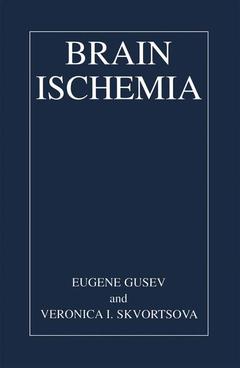Brain Ischemia, Softcover reprint of the original 1st ed. 2003
Langue : Anglais
Auteurs : Gusev Eugene I., Skvortsova Veronika I.

Ischemia is localized tissue anemia due to obstruction of the inflow of arterial blood, thus brain ischemia is the condition where insufficient blood is delivered to the brain. Many physiological processes occurring in the brain critically depend on the state of its energy metabolism. The state of brain energy metabolism in turn depends on the delivery of oxygen and glucose to the brain via the bloodstream. Although it comprises only 2% of the total body weight, the human brain consumes 20-25% of the oxygen and up to 70% of the free glucose taken in by the body. The brain respires more intensively than any other organ of the body. The intensity of oxygen consumption by cortical brain tissue much exceeds the demands of other tissues (5.43 mmol 02/g per h versus 3.06 and 4.02 mmol for heart at rest and intensively working, respectively, 2.4 mmol for kidneys, and 1.8 mmol for liver). Oxidative phosphorylation in mitochondria generates 95% of the adenosine triphosphate (ATP) that is formed in the brain. Thus, it is clear why insufficiency of oxygen delivery to brain cells adversely affects brain function. Glucose is the main energy-providing substrate in the brain. The basic pathway of its metabolism in neural tissue is aerobic glycolysis.
Introduction. Part I: Mechanisms of Ischemic Brain Damage. 1. Hemodynamic Events Associated with Acute Focal Brain Ischemia and Reperfusion. Ischemic Penumbra. 2. Cellular Reactions in Response to Acute Focal Brain Ischemia. 3. Energy Failure Induced by Brain Ischemia. 4. The Glutamate-Calcium Cascade. 4.1. The Induction Stage: Energy-Dependent Ion Pump Failure And Glutamate Excitotoxicity. 4.2. The amplification stage: intracellular accumulation of calcium ions, spreading glutamate release, spreading depression waves. 4.3. The expression stage: calcium-inducedactivation of intracellular enzymes, oxidative stress and abundant NO production, and accumulation of low molecular weight cytotoxic substances. 5. Metabolic Acidosis and Ischemic Damage. 6. Delayed Neuronal Death Following Acute Focal Brain Ischemia. 7. Gene Expression and Subsequent Molecular Events in Response to Acute Brain Ischemia. 8. Microglial Activation, Cytokine Production, and Local Inflammation in Focal Brain Ischemia. 8.1. Dynamics of pro-inflammatory and regulatory cytokines and C-reactive protein concentration in CSF of patients with acute ischemic stroke. 8.2. Microvascular-cellular cascade and secondary brain damage. 9. Autoimmune Mechanisms of Trophic Dysfunction and Ischemic Brain Damage. 9.1. Nerve growth factor (NGF) and its autoantibody concentration in CSF and serum of patients with ischemic stroke. 9.2. Neurospecific protein S100b and its autoantibody concentration in CSF and serum of patients with ischemic stroke. 9.3. Myelin basic protein and its autoantibody concentration in CSF and serum of patients with ischemic stroke. 9.4. Content of autoantibodies to NGF, S100beta, and MBP in serum of patients with chronic brain ischemia. 10. Programmed Cell Death. Apoptosis in Focal Brain Ischemia. 11. Reaction of the Stress-Mediating Endocrine System in Response to Acute Brain Ischemia. 12. Molecular Mechanisms of Post-Ischemic Reparation Events. Part II: Neuroprotection in Brain Ischemia. 13. Modern Therapeutic Approaches to Acute Focal Brain Ischemia. Basic Strategies for Neuroprotection. 14. Primary Neuroprotection. 14.1. Potential-dependent calcium channel antagonists. 14.2. Glutamate receptor antagonists. 14.3. Inhibitors of synthesis and pre-synaptic release of glutamate. 14.4. GABA agonists. 14.5. Glycine. 15. Secondary Neuroprotection. 15.1. Antioxidants. 15.2. Anti-intercellular adhesion molecule (anti-ICAM) antibodies. 15.3. Pro-inflammatory cytokine inhibitors; anti-inflammatory factors. 15.4. Statins and estrogens. 15.5. Neurotrophic factors. 15.6. Neuropeptides. 15.7. Gangliosides. 15.8. Prevention of apoptosis. 16. Reparative Therapy. 16.1. Piracetam. 16.2. Citicoline sodium. 16.3. Gliatilin. 16.4. Carnitine chloride. 17. Strategies and Prospects for Development of Neuro-protective Therapy for Brain Ischemia. Conclusion. Index.
Date de parution : 10-2012
Ouvrage de 382 p.
15.2x22.9 cm
Disponible chez l'éditeur (délai d'approvisionnement : 15 jours).
Prix indicatif 158,24 €
Ajouter au panierDate de parution : 06-2005
Ouvrage de 406 p.
Thèmes de Brain Ischemia :
Mots-clés :
brain; death; depression; glutamate receptor; neuropeptides; neuroprotection; oxidative stress; receptor; stroke
© 2024 LAVOISIER S.A.S.



